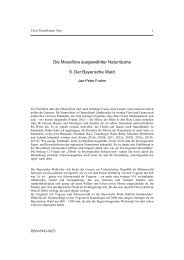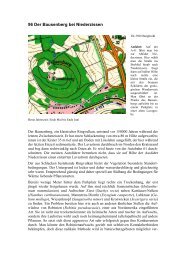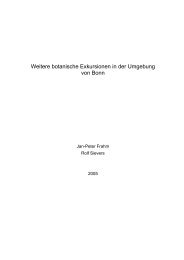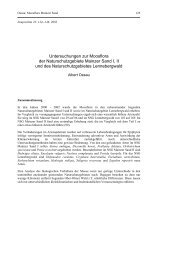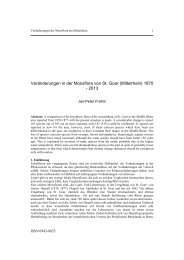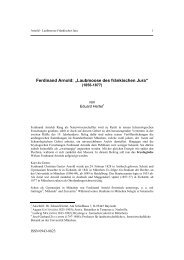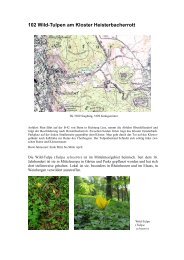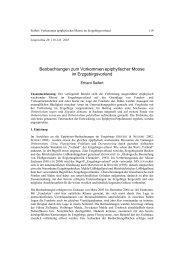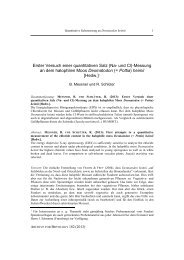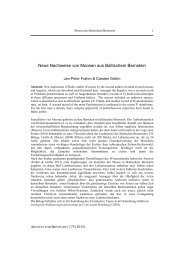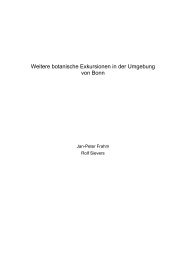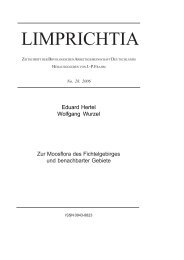Limprichtia xx: nn-nn, 2001 - Jan-Peter Frahm
Limprichtia xx: nn-nn, 2001 - Jan-Peter Frahm
Limprichtia xx: nn-nn, 2001 - Jan-Peter Frahm
Create successful ePaper yourself
Turn your PDF publications into a flip-book with our unique Google optimized e-Paper software.
4. Phytogeographical elements<br />
Mossflora Mascarenes 5<br />
The Mascarenes are located approx. 3300 km (Seychelles) or 5000 km (Réunion, Mauritius)<br />
away from Indonesia but only 800 km (Réunion) viz. 980 km away from Madagascar. This should<br />
cause a stronger floristic affinity to Africa. On the other hand, the prevailing wind system is the SE<br />
trade wind.<br />
The presence of SE-asiatic floristic elements on the Mascarenes can be explained (except for<br />
introduction by man) mainly by long distance dispersal and demonstrate the enormous success of<br />
spore dispersal. The spores are released in the source range and dispersed over the Indian Ocean,<br />
in which the islands cover only an extremely small part. The size of the Indian Ocean between<br />
Indonesia and the Mascarenes is about 14 million km 2 , whereas the area of the islands is about<br />
6000 km 2 . So the chance for a spore to meet an island is 1:2333. The chance is even much lower if<br />
one considers that the species does not occur everywhere in the source range and if it lands on an<br />
island, must meet an appropriate habitat.<br />
It is difficult to set up a list of phytogeographical elements of all species due to the lack of<br />
information. However, a genus can be used for a case study. Campylopus is one of the largest<br />
moss genera and almost worldwide distributed. It is present on the Mascarenes with 25 species and<br />
therefore quite representative. These 25 species belong to the following phytogeographical<br />
elements:<br />
1. African: arctocarpus, arcuatus, aureonitens, cambouei, crateris, flaccidus, flavicoma,<br />
hildebrandtii, julaceus, nanophyllus, praetermissus, pseudobicolor, robillardei,<br />
smaragdinus, trachyblepharum.<br />
2. neotropical and African (tropical montane-subalpine): jamesonii, fragilis, flexuosus,<br />
pilifer, nivalis.<br />
3. Austral: introflexus, pyriformis.<br />
4. SE-Asian: schmidii.<br />
5. Endemic: fuscolutescens.<br />
6. Gondwanan: thwaitesii.<br />
Fifteen of twenty-five species belong to the African element, which seems to be not surprising<br />
since this is the nearest continent. However, Africa is situated against the prevailing wind system!<br />
Four species are endemic on the Seychelles but no one is known from Mauritius (tab. 1) , which<br />
reflects the younger age. In contrast, seventy-two species were indicated as endemic for Réunion<br />
(17%) by Ah-Peng & Bardat (2005), a number which is certainly wrong because many of the<br />
species marked as endemic are more widespread. Generally the indication of rates of endemism in<br />
bryophytes are dubious because they will not last long but tend to decline with increasing<br />
taxonomic and floristic research.<br />
5. Discussion<br />
The low number of species common in all islands is a strange fact, especially under consideration<br />
that the climatic conditions on all islands are comparable. It corroborates somewhat the hypothesis<br />
that mosses are widespread, have wide ranges and are easily dispersed.<br />
A similar analysis has been performed with the islands of the Azores (<strong>Frahm</strong> ). It resulted in the<br />
fact that neither distance, altitude, size or age of the islands correlate with the species numbers und<br />
led to the conclusion that the distribution pattern of bryophytes is primarily based in chance.<br />
Chance (or unknown reasons) seems also to determine the moss flora of the Mascarenes.<br />
ARCHIVE FOR BRYOLOGY 55 (2009)




